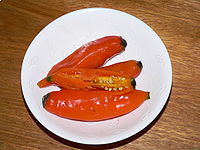
Ají pepper
Encyclopedia
Capsicum baccatum is a species of chili pepper
that includes the following cultivar
and varieties
:
, and is considered part of its condiment trinity together with red onion and garlic. Aji amarillo literally means yellow chili; however, the yellow color appears when cooked, as the mature pods are bright orange.
Today the Ají amarillo is mainly seen in South American markets and food stores around the world where Peruvian and Bolivian expatriates are numerous. The wild baccatum species (C. baccatum var. baccatum) is most common in Bolivia with outlier populations in Peru (rare) and Paraguay, northern Argentina, and southern Brazil.
 Pepper varieties in the C. baccatum species have white or cream colored flowers, and typically have a green or gold corolla. The flowers are either insect or self-fertilized. The fruit pods of the baccatum species have been cultivated into a wide variety of shapes and sizes, unlike other capsicum species which tend to have a characteristic shape. The pods typically hang down, unlike a Capsicum frutescens
Pepper varieties in the C. baccatum species have white or cream colored flowers, and typically have a green or gold corolla. The flowers are either insect or self-fertilized. The fruit pods of the baccatum species have been cultivated into a wide variety of shapes and sizes, unlike other capsicum species which tend to have a characteristic shape. The pods typically hang down, unlike a Capsicum frutescens
plant, and can have a citrus or fruity flavor.
and Bolivian cuisine
as a condiment, especially in many dishes and sauces. In Peru the chilis are mostly used fresh, and in Bolivia dried and ground. Common dishes with aji amarillo are the Peruvian stew Aji de Gallina ("Chili of Hen"), Huancaina sauce and the Bolivian Fricase Paceno, among others.
culture often represented fruits and vegetables in their art, including Ají amarillo peppers.
Chili pepper
Chili pepper is the fruit of plants from the genus Capsicum, members of the nightshade family, Solanaceae. The term in British English and in Australia, New Zealand, India, Malaysia and other Asian countries is just chilli without pepper.Chili peppers originated in the Americas...
that includes the following cultivar
Cultivar
A cultivar'Cultivar has two meanings as explained under Formal definition. When used in reference to a taxon, the word does not apply to an individual plant but to all those plants sharing the unique characteristics that define the cultivar. is a plant or group of plants selected for desirable...
and varieties
Variety (biology)
In botanical nomenclature, variety is a taxonomic rank below that of species: as such, it gets a three-part infraspecific name....
:
- Aji amarillo, or amarillo chili
- PeppadewPeppadewPeppadew is the brand name of sweet piquanté peppers grown in the Limpopo province of South Africa.-History:This type of piquante pepper was first discovered in early 1993 and introduced to market later that same decade...
- Lemon drop
- Bishop's CrownBishop's CrownThe Bishop's Crown or Christmas Bell, is a pepper, a variety of the species Capsicum baccatum var. pendulum. It is named for its distinct three-sided shape resembling a Bishop's Crown.Although this variety can be found in Barbados,...
- Brazilian Starfish
- Wild Baccatum
Origins and distribution
The C. baccatum species, particularly the Ají amarillo chili (Aji is the caribean word for chili and/or peppers that the Spaniards colonizers extended to most of Central and South America), is typically associated with Peruvian cuisinePeruvian cuisine
Peruvian cuisine reflects local cooking practices and ingredients—and, through immigration, influences from Spain, China, Italy, West Africa, and Japan. Due to a lack of ingredients from their home countries, immigrants to Peru modified their traditional cuisines by using ingredients...
, and is considered part of its condiment trinity together with red onion and garlic. Aji amarillo literally means yellow chili; however, the yellow color appears when cooked, as the mature pods are bright orange.
Today the Ají amarillo is mainly seen in South American markets and food stores around the world where Peruvian and Bolivian expatriates are numerous. The wild baccatum species (C. baccatum var. baccatum) is most common in Bolivia with outlier populations in Peru (rare) and Paraguay, northern Argentina, and southern Brazil.
Description

Capsicum frutescens
Capsicum frutescens is a species of chili pepper that includes the following cultivar and varieties:*Piri piri, also called African Bird's Eye or African devil* Kambuzi pepper, Malawian pepper*Malagueta pepper*Tabasco pepper, used to make Tabasco sauce...
plant, and can have a citrus or fruity flavor.
Culinary usage
Aji amarillo is one of the ingredients of Peruvian cuisinePeruvian cuisine
Peruvian cuisine reflects local cooking practices and ingredients—and, through immigration, influences from Spain, China, Italy, West Africa, and Japan. Due to a lack of ingredients from their home countries, immigrants to Peru modified their traditional cuisines by using ingredients...
and Bolivian cuisine
Bolivian cuisine
Bolivian cuisine of Bolivian cuisine are corn, potatoes and beans. These ingredients have been combined with a number of staples brought by the Spanish, such as rice, wheat and meat, such as beef, pork and chicken.-Examples:* Ají* Anticuchos...
as a condiment, especially in many dishes and sauces. In Peru the chilis are mostly used fresh, and in Bolivia dried and ground. Common dishes with aji amarillo are the Peruvian stew Aji de Gallina ("Chili of Hen"), Huancaina sauce and the Bolivian Fricase Paceno, among others.
Use by Moche
The MocheMoche
'The Moche civilization flourished in northern Peru from about 100 AD to 800 AD, during the Regional Development Epoch. While this issue is the subject of some debate, many scholars contend that the Moche were not politically organized as a monolithic empire or state...
culture often represented fruits and vegetables in their art, including Ají amarillo peppers.

